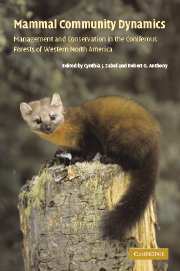 Mammal Community Dynamics
Mammal Community Dynamics Book contents
- Frontmatter
- Contents
- List of contributors
- Foreword
- Acknowledgments
- Part I Management and conservation issues for various taxa
- Part II Community and ecosystem relations
- Part III Conservation issues and strategies
- 16 Small mammals in a landscape mosaic: implications for conservation
- 17 Measuring and interpreting connectivity for mammals in coniferous forests
- 18 An evolutionary and behavioral perspective on dispersal and colonization of mammals in fragmented landscapes
- 19 The functional diversity of mammals in coniferous forests of western North America
- 20 Synopsis and future perspective
- Index
- References
20 - Synopsis and future perspective
Published online by Cambridge University Press: 15 December 2009
- Frontmatter
- Contents
- List of contributors
- Foreword
- Acknowledgments
- Part I Management and conservation issues for various taxa
- Part II Community and ecosystem relations
- Part III Conservation issues and strategies
- 16 Small mammals in a landscape mosaic: implications for conservation
- 17 Measuring and interpreting connectivity for mammals in coniferous forests
- 18 An evolutionary and behavioral perspective on dispersal and colonization of mammals in fragmented landscapes
- 19 The functional diversity of mammals in coniferous forests of western North America
- 20 Synopsis and future perspective
- Index
- References
Summary
Introduction
Landscapes of western North America have been highly dissected by glaciation, vulcanization, physiographic heterogeneity, and the formation of major river systems. These physical features have served as barriers to movement and gene flow among mammal populations resulting in speciation throughout evolutionary history. As a result of these many influences and resulting speciation, the mammal fauna of this area is highly rich and diverse. About half of the mammalian species in North America occur in western coniferous forests (see Lawlor 2003). Although fewer species are found specifically within these forests, most are widespread in many vegetative communities.
Mammalian faunas of coniferous forests of western North America represent many taxonomic groups, and they perform many functional roles. Shrews are little known but are often the most abundant species in these forests, and they are primarily insectivorous, as are bats. In contrast, ungulates are highly visible and represent large amounts of standing biomass in forested ecosystems. Their browsing and herbivorous diets can have a major influence on plant communities and other species of mammals.
Direct associations between coarse woody debris and mammals vary among species and studies, but most information on this association is for the terrestrial small mammals. For many species, coarse wood debris serves as an important form of cover or as feeding sites (McComb 2003). For example, martens use downed logs as important hunting sites during the winter when snow is deep.
- Type
- Chapter
- Information
- Mammal Community DynamicsManagement and Conservation in the Coniferous Forests of Western North America, pp. 665 - 678Publisher: Cambridge University PressPrint publication year: 2003


